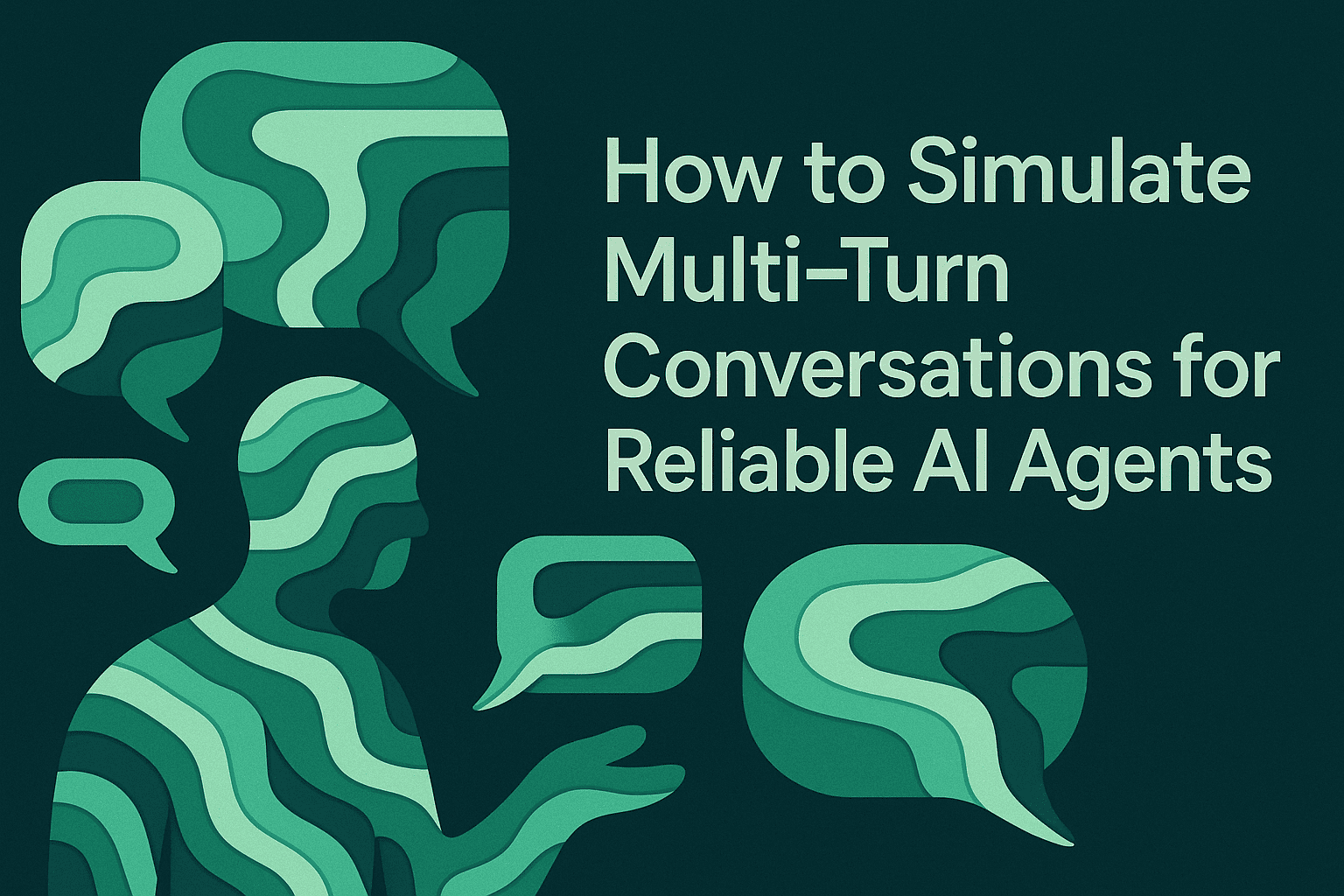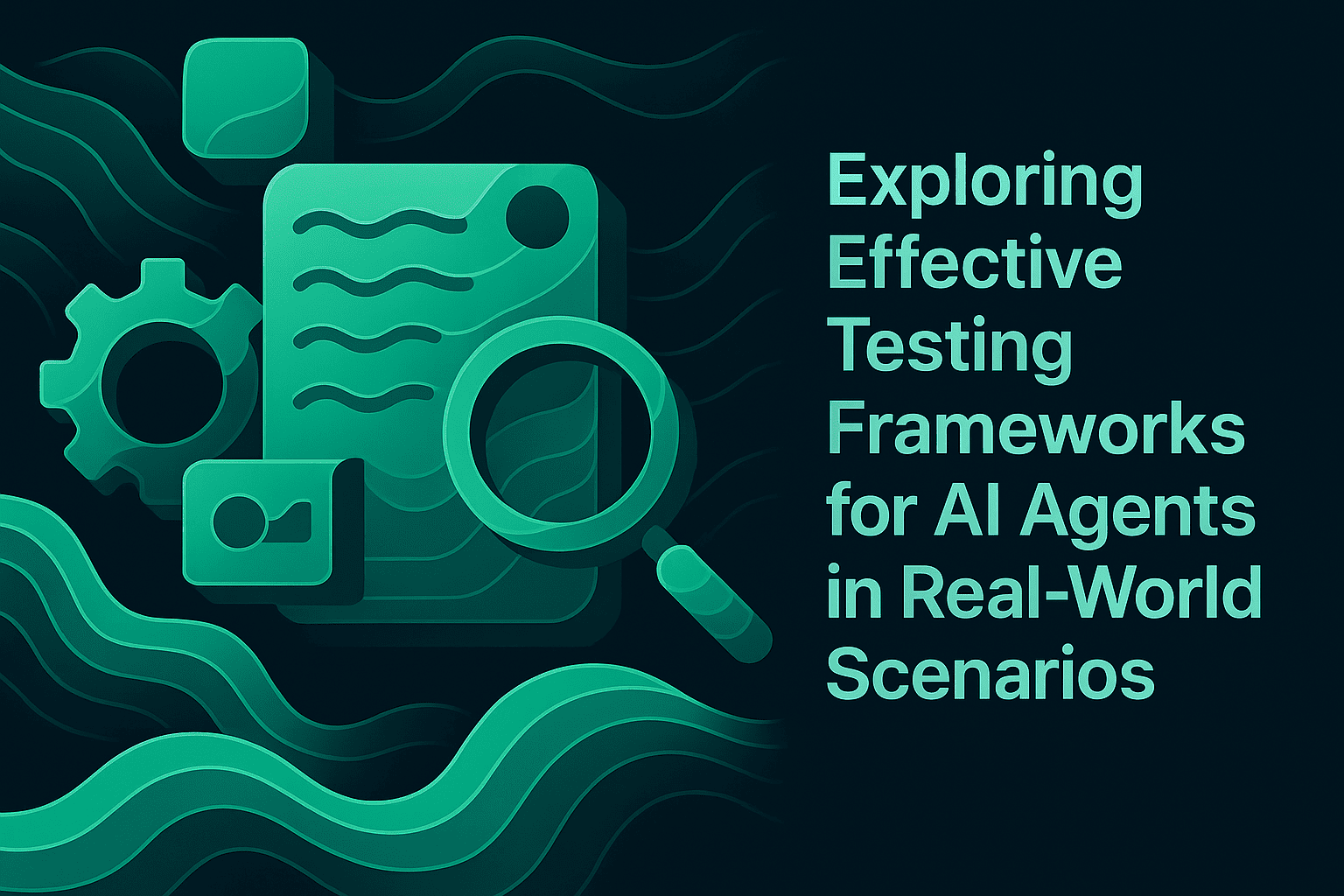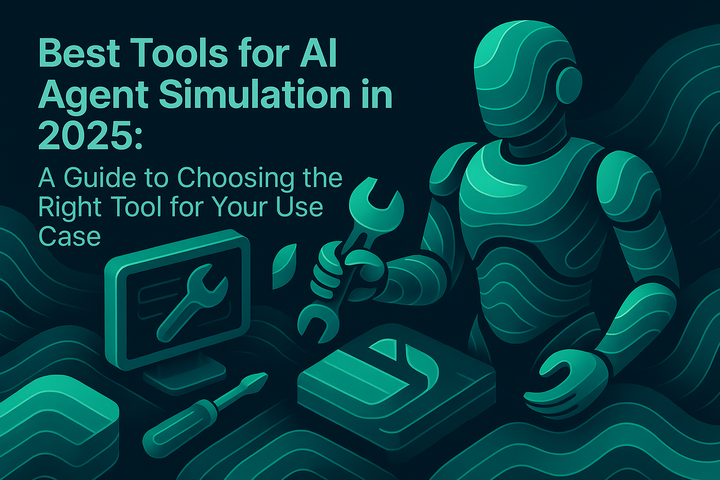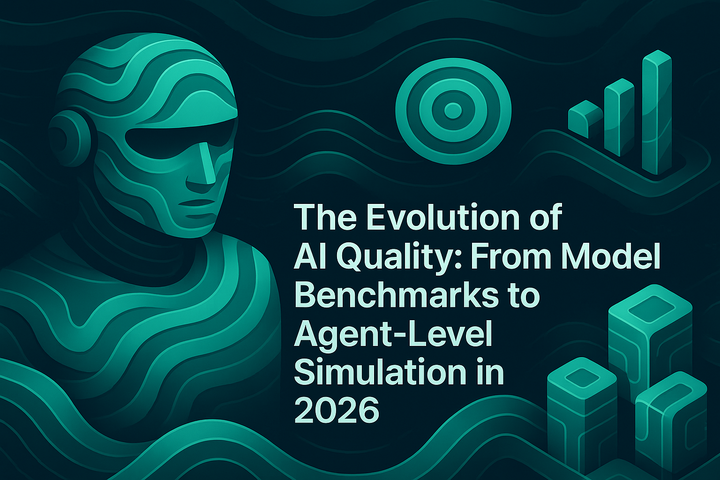How to Simulate Multi-Turn Conversations to Build Reliable AI Agents

TLDR;
Multi-turn simulation exposes failure modes you’ll miss with single-turn tests. Using structured scenarios, personas, and evaluator-driven analysis across datasets, teams can track metrics such as step completion, overall task success, adherence to instructions, and conversational drift in longer interactions. Maxim AI provides end-to-end capabilities: simulation, evaluation, and observability, to operationalize AI agent reliability at scale with rigorous, repeatable workflows.
Introduction
As AI agents move from static Q&A to dynamic task execution (calling tools, applying policies, and maintaining context across turns), traditional unit tests and basic checks fall short. Failure modes like hallucinations, privacy leaks, poor trajectory choices, and brittle tool invocation patterns often appear only when agents are tested through multi-turn interactions that mirror diverse real-world scenarios and user personas. To ship reliable agents, teams need structured, repeatable simulations backed by robust evaluation and observability.
This guide provides a practical framework to design scenarios and personas, build test datasets for agents, configure test runs, instrument tracing, and set up automated regression testing, rerunning key evaluations to ensure new changes don’t break existing functionality. It draws on workflows and capabilities in the Maxim AI platform: Agent Simulation & Evaluation, Observability, and Experimentation.
What Are Multi-Turn Conversations in AI Agents?
Single-turn interactions evaluate a one-shot response. In production, users clarify, redirect, and provide partial signals over many turns. Multi-turn testing validates the agent’s ability to:
- Maintain and update context state across turns
- Choose the correct trajectories across steps and tools
- Recover from errors, ambiguity, or missing information
- Complete goals coherently across long horizons
Maxim’s approach centers on granular instrumentation and evaluators at session, trace, and span levels. Teams simulate user personas, role-play realistic flows, and measure task success and coherence across turns. From the UI, product teams configure flexible evaluations, while engineering teams integrate SDKs to run fine-grained checks during CI and regression testing. Explore Agent Simulation and Evaluation, Maxim’s LLM testing framework, and Agent Observability.
Simulations pair a synthetic virtual user with your agent, run sessions until success or max turns, and log every request, response, and tool call. Evaluators cover PII leakage, trajectory completion, hallucination risk, latency, and cost.
Why Simulate Multi-Turn Conversations for Reliable AI Agents?
Traditional single-turn QA often misses challenges in extended, multi-step tasks, where context needs to be remembered over time. This can lead to compounding bias and context drift.. Multi-turn simulation provides repeatable, controlled environments to probe edge cases, challenging scenarios, and complex workflows before real users are impacted.
Key benefits:
- Scalability: Generate hundreds of scenario permutations and personas to expand coverage efficiently. Maxim’s synthetic data and curated datasets streamline maintenance. See curated datasets for AI agent testing.
- Fairness and Robustness: Capture diverse user behaviors, linguistic patterns, and accessibility concerns. Evaluations are configurable with rule-based, statistical, and LLM-as-judge methods in a unified framework. See the Evaluator Store
- Cost and efficiency: Reduce evaluation overhead by reusing datasets, running parallel simulations, and leveraging caching to lower latency and cost while preserving consistency
- Observability: Reproducible, instrumented experiments surface root causes quickly. With observability, continuously validate live logs against evaluation criteria and curate datasets for iterative improvement.
Maxim’s Approach to Multi-Turn Simulation
Maxim AI provides an end-to-end stack to design, run, and evaluate multi-turn simulations with deep traceability.
Core capabilities:
- Scenario and persona modeling: Define conversational goals, constraints, and user behaviors. Simulations run across personas to measure generalization and task completion.
- Session, trace, and span granularity: Instrument agents to capture decisions, tool calls, RAG retrievals, and intermediate state for agent and LLM tracing. This supports focused debugging and hallucination detection in complex flows.
- Evaluator framework: Configure off-the-shelf or custom evaluators – deterministic rules, statistical checks, and LLM-as-judge – to quantify chatbot, RAG, copilot, and agent performance at multiple levels.
- Experimentation and prompt versioning: Organize prompts, version changes, and compare quality, cost, and latency across models and parameters.
Agent Datasets
Datasets let you scale multi-turn testing from a handful of cases to hundreds. Use column types and templates designed for agent simulation and evaluation.
- Dataset templates: Choose the Agent Simulation template for multi-turn conversations, or Prompt/Workflow Testing for single-turn validation. Use Dataset Testing to compare expected vs actual outputs when ground truth exists.
- Scenario column: Describe the background, user intent, and environment so the simulator can initiate a realistic conversation.
- Expected Steps: Enumerate the ideal sequence of actions – greet, verify, invoke tool, apply policy, request confirmation, complete. This turns “did it do well?” into measurable trajectory compliance.
- Expected Tool Calls: Specify tool selection with arguments. Use combinators like inAnyOrder for mandatory-but-flexible ordering, or anyOne when multiple tools can satisfy the requirement.
- Conversation History: Provide prior messages (user, assistant, tool) as JSON to simulate context continuity and test the incorporation of the historical state.
Import datasets by CSV, append over time, and attach images for multimodal scenarios. Consistent column mapping ensures repeatable, scaled runs across versions.
Simulation Runs
With scenarios, personas, and expectations in place, set up a reproducible simulation run.
- Test-run configuration: From an HTTP endpoint, select Simulated session, choose your agent dataset, and configure persona, tools, and context sources. Enable evaluators relevant to your goals.
- Evaluators: Apply PII detection, trajectory compliance, hallucination checks, and performance metrics (latency, cost). Evaluators provide objective status chips and detailed notes per session to verify adherence and diagnose failures.
- Execution: Trigger the run to simulate conversations for each dataset scenario. The system logs requests, responses, and tool calls across turns.
- Review results: Inspect transcripts, evaluator outcomes, and metrics. Use dashboards to compare runs across versions and time.
Maxim’s Playground++ supports AI-powered multi-turn simulations directly in the prompt playground. Teams can bring their own prompts, connect MCP tools, integrate RAG pipelines, and launch thousands of scenario simulations with a single click.
Example of an Enterprise customer-support chatbot
- Goal: Resolve billing and plan changes across turns with authentication and policy constraints.
- Simulation: Personas include new users, returning users, and escalations. Edge cases include ambiguous intents, partial account info, and adversarial inputs.
- Measurement: Track task success rate, first-pass resolution, compliance adherence, and state consistency across six to ten turns. Reproduce failures by re-running from specific steps.
- Operationalization: Once validated, deploy the agent behind Bifrost, an open-source LLM gateway, to enable automatic fallbacks, semantic caching, and reliable model routing. Monitor traces in Agent Observability with real-time quality checks.
Techniques for Building Reliable Multi-Turn Simulations
Use the following techniques to craft robust, production-grade simulations:
- Role-playing agents and adaptive personas: Simulate clarifications, interruptions, and constraint updates. Configure trajectory evaluators to assess whether the agent chose appropriate tools or retrieval steps. See Agent Simulation.
- Adaptive simulation models: Drive agents to encounter ambiguity and recover gracefully using smart fallback strategies. Validate reduction in context drift by inspecting traces and span-level decisions.
- RLHF-aligned evaluation: Combine human-in-the-loop reviews with LLM-as-judge evaluators to align responses with enterprise preferences, compliance rules, and tone.
- Prompt lifecycle management: In Experimentation, organize prompts, compare versions, and deploy variants with different parameters. Track quality, cost, and latency to ensure improvements do not regress multi-turn reliability.
- Voice simulation: For voice-first products, use audio pipelines with streaming, transcription, and metrics like response latency and talk ratio to ensure natural turn-taking and intelligibility across accents and speech rates. Configure providers such as Twilio or Vapi, set the initiator of the first message, and review transcripts, audio recordings, and metrics. See Voice Simulation.
Challenges in Multi-Turn Simulation and How Maxim AI Solves Them
- Context drift: Long conversations often degrade state fidelity, leading agents to lose track of prior turns. Span-level tracing and consistency evaluators make drift visible, quantify recovery strategies, and give developers fine-grained observability into how the agent manages context over time. This ties directly to AI agent reliability best practices.
- Ambiguity and adversarial inputs: Multi-turn flows must withstand prompt injections, jailbreaks, and ambiguous requests. Policy evaluators and tool-use constraints act as guardrails, enforcing safety policies and ensuring the agent stays aligned with intended behaviors across turns.
- Bias and fairness: Reliable agents need to work consistently across diverse user groups. By simulating varied personas and datasets, then applying statistical evaluators to flag disparate error rates, teams can surface fairness issues. Combining this with human review provides the nuance needed for trustworthy decision-making.
- Reproducibility: Reliability depends on repeatable results. The ability to re-run from any step, isolate failing branches, and compare against prior baselines ensures regressions are caught early and fixes can be validated before production deployment.
Evaluation Metrics for Reliable AI Agents
Reliable multi-turn agents are measured beyond single-response accuracy. Core metrics include:
- Accuracy and relevance: Correctness with respect to ground truth or retrieved context
- Coherence and consistency: Logical continuity across turns and adherence to constraints
- Engagement and efficiency: Turns-to-resolution, escalation rates, and user effort
- Task success: Binary or graded success on end goals such as authentication, policy compliance, and tool outcomes
- Agent trajectory: Alignment with expected steps and tool calls, rather than skipping or drifting mid-task
By combining outcome-based measures (such as task completion) with process-based ones (such as adherence to intended steps), teams can move from vague judgments of ‘did it do well?’ to clear, measurable results.
The Maxim evaluation framework makes this practical by letting teams:
- Run and visualize results across large test suites
- Compare different versions side by side
- Automate checks in CI/CD pipelines for continuous validation
- Layer in human evaluation for nuanced assessments before release
Learn more in our guides on Agent Simulation and Testing, Metrics for Agent Observability, and AI Agent Quality Assurance.
Best Practices for Multi-Turn Simulation
- Combine real-world logs with synthetic simulations: Curate datasets using production traces for realistic coverage and iterate with synthetic variants to expand edge-case breadth.
- Instrument deeply: Capture decisions at session, trace, and span, and log tool invocations, RAG retrievals, and intermediate states for tracing across text and voice agents. See Agent Observability.
- Use flexible evaluators: Run agent and model evaluations through deterministic rules, statistical checks, and LLM-as-judge, configurable at multiple granularities. See Agent Simulation and Evaluation.
- Manage prompts as first-class artifacts: Version, compare, and deploy prompts using Experimentation, enabling safe iteration without code changes.
- Data operations: Import datasets by CSV, update over time, and attach images for multimodal scenarios while keeping column mappings consistent.
Real-World Use Cases Powered by Maxim AI
- Customer service automation: Validate authentication, policy adherence, and resolution workflows. Re-run failing steps and fix prompts or tooling. See Agent Simulation and Evaluation.
- Healthcare conversational agents: Evaluate state consistency and compliance messaging across long interactions. Instrument decisions in Observability.
- E-commerce and sales copilots: Test browsing, retrieval, recommendation, and checkout flows with copilot evaluations and trajectory checks.
- Enterprise copilots: Validate tool-use via MCP integrations and govern cost and latency with gateway features such as governance and semantic caching. See Bifrost.
The Future of Multi-Turn Simulation with Maxim AI
Enterprises are moving toward multi-agent systems and long-term memory. Maxim’s full-stack approach: simulation, evaluations, experimentation, and observability, provides a consistent path to reliability across both pre-release and production.
Looking ahead, simulation will be key to building robust test suites that capture the diversity of real-world interactions. By modeling a wide range of personas, contexts, and edge-case scenarios, teams can systematically stress-test agents before deployment and catch failure modes early. Evaluations layered on these simulations turn qualitative observations into measurable, repeatable results - from task success rates to conversational drift across extended interactions.
Conclusion:
Reliable AI agents are built through steady improvement, not one-time testing. Multi-turn simulation helps uncover weak spots early, while evaluation workflows and observability keep performance accountable once the agent is live. Measuring outcomes alongside the process of how results are achieved gives teams a clear view of progress.
The key is to keep the loop active: test, deploy, monitor, and refine. Over time, this cycle builds trust and shows that the agent can handle real-world complexity with consistency. With Maxim AI, teams can design realistic scenarios, evaluate performance, and improve continuously through observability - shipping trustworthy AI faster and with greater confidence.
Explore Maxim’s stack for Agent Simulation and Evaluation and Observability to strengthen reliability across your AI lifecycle.
👉 Request a demo: getmaxim.ai/demo


